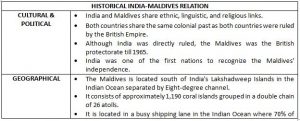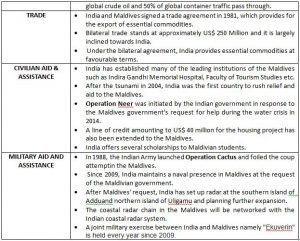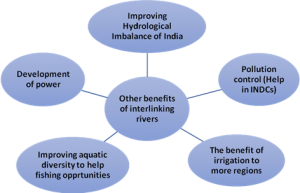INDIA-MALDIVES PROMISES, POSSIBILITIES AND CHALLENGES
THE CONTEXT: In Feb-March 2022, India and Maldives have dived into a new foray into strategic relations with bilateral meetings on various fronts. There have been high-profile visits of Indian dignitaries to the Maldives. This article analyses regional security and maritime safety issues along with socio-economic development, trade and investment, and tourism at a time when the “India Out” campaign is regaining momentum in the Maldives along with challenges of Chinese influence and others.
MOST RECENT DEVELOPMENTS IN INDIA-MALDIVES RELATIONSHIPS
DEFENCE COOPERATION DIALOGUE:
- Defence Secretary of India visited the Maldives on 13-14 Feb 2022, with the primary objective of discussions on the 3rd Defence Cooperation Dialogue(DCD).
- Both sides discussed joint efforts and capacity-building initiatives being taken by both the countries to deter trans-national crimes and bolster national security in the region.
- The Defence Secretary of India also inaugurated the Composite Training Center Phase-I Annex built with Indian grant assistance in the Maldives and handed over the refitted CGS Huravee – a made-in-India patrol vessel.
COLOMBO SECURITY CONCLAVE:
- NSA of India visited the Maldives on 7 March 2022 to attend the 5th NSA level Colombo Security Conclave (CSC) meeting.
- The four pillars of security cooperation (in CSC) include maritime safety and security, human trafficking, counter-terrorism, and cyber security.
- India, the Maldives, and Sri Lanka are the founding members of the Colombo Security Conclave. Mauritius was included as a new member of the conclave during the meeting, which was also attended by Bangladesh and Seychelles as observers in 2022.
CAG LEVEL BILATERAL MEET TO STRENGTHEN PROFESSIONAL CAPABILITIES IN MALDIVES:
- Steps were taken for furthering the cooperation between the two Supreme Audit Institutions (SAI) by operationalizing the MoU to strengthen the professional capacities and improve audit methodology.
- Emphasized the role of technology, in today’s rapidly changing world, which constantly creates fresh avenues for audit and makes audits more efficient. The exchange of knowledge and capacity development initiatives would equip both the SAIs in the use of emerging technologies for auditing.
- The MOU is signed at the most opportune time given the strategic shift towards future relevance which requires both the countries to cater to the demands of the knowledge economy and sustainable development.
VISIT OF EXTERNAL AFFAIRS MINISTER TO MALDIVES:
- Inauguration of National College for Policing and Law Enforcement (NCPLE):
- NCPLE is one of India’s largest funded projects in the island nation – in the Maldives’ Addu City
- One of the objectives of this training academy is to address the challenges of violent extremism and prevent radicalisation.
- On the domestic level in the Maldives, the training academy would help strengthen law enforcement abilities and counter drug trafficking, a major concern in the country.
- MoU for Training: A memorandum of understanding was signed by the
- Maldives Police Service and India’s Sardar Vallabhbhai Patel National Police Academy to enhance cooperation in training and capacity building. India has also increased the number of training slots for the Maldives at the police academy to eight.
- Support for Infrastructure: The project for the creation of police infrastructure facilities across the islands of Maldives with over $40 million financing from EXIM Bank of India has also been given necessary approvals.
INDIA OUT CAMPAIGN AND INDIA OUT BILL:
- India Out campaign has cropped up every now and then within the Indian Ocean island nation, mostly on social media. The campaign is led by critics who accuse the present government of allowing Indian boots on the ground and thereby compromising the sovereignty of the island nation. The ruling administration has time and again denied any Indian military presence in the country or a threat to Maldives’s sovereignty.
- India Out Bill is a draft Bill by the present Maldivian government that criminalises public campaigns that apparently harm Maldives’ relations with foreign countries.
AN ANALYSIS OF RECENT VISITS
- The Maldives holds strategic importance for India under the present government’s ‘Neighbourhood First’ policy due to its location in the Indian Ocean. However, the relations between the two countries were strained under the pro-China regime of their former President Abdulla Yameen. This can be reflected in the recent ‘India Out’ campaign led by Abdulla Yameen, against India’s massive developmental funding for creating physical, social, and community infrastructure, and incumbent President Solih’s government retaining two India-gifted helicopters and their operational military personnel.
- For India, the Indian Ocean is of utmost importance. Since 2014, India has taken a proactive approach to cement its role as the leader in the Indian Ocean by according priority maritime diplomacy and initiatives. This comes against the backdrop of rising Chinese assertiveness in the IOR and the growing interest of various powers in the Indian Ocean generally, and the Maldives in particular. As the pre-eminent South-Asian power and net security provider in the Indian Ocean Region, India needs to cooperate in all dimensions with the Maldives. The recent bilateral meetings between India and Maldives will offer India the right opportunity.
AREAS OF ENGAGEMENT INDIA-MALDIVES RELATIONS
GEO-STRATEGIC: The Maldives, a Toll Gate in the Indian Ocean:
- Located in the southern and northern parts of this island chain lies the two important Sea Lanes of Communication (SLOCs). These SLOCs are critical for maritime trade flow between the Gulf of Aden and Gulf of Hormuz in West Asia and the Strait of Malacca in Southeast Asia.
- Nearly 50% of India’s external trade and 80% of its energy imports transit these SLOCs in the Arabian Sea.
- The location of the Maldives, at the intersection of commercial sea lanes running through the Indian Ocean, makes it strategically important for India, particularly in light of China’s growing aggression in the region.
IMPORTANT GROUPINGS:
- Maldives is a member of the South Asian Association for Regional Cooperation (SAARC) and the South Asia Subregional Economic Cooperation (SASEC).
- Engagement with QUAD (India, Japan, Australia, and the US)
- Maldivian engagement with the ‘Quad’, has been growing over the last year, especially in the area of defense cooperation.
- The present government signed a ‘Framework for a Defence and Security Relationship’ agreement with the United States. It was welcomed by India.
The South Asia Subregional Economic Cooperation (SASEC) program set up in 2001 brings together Bangladesh, Bhutan, India, Maldives, Myanmar, Nepal, and Sri Lanka in a project-based partnership that aims to promote regional prosperity, improve economic opportunities, and build a better quality of life for the people of the subregion. SASEC countries share a common vision of boosting intraregional trade and cooperation in South Asia, while also developing connectivity and trade with Southeast Asia through Myanmar, the People’s Republic of China, and the global market.
SECURITY COOPERATION:
- India and Maldives conduct the joint military exercise ‘Ekuverin’ every year since 2009.
- Mauritius was included as a new member of the conclave during the fifth meeting of national security advisers of the Colombo Security Conclave. It is a maritime security grouping of India, Sri Lanka, Maldives, and Mauritius to forge closer cooperation on maritime and security matters among these Indian Ocean countries.
- MILAN, a Multilateral Naval Exercise hosted by India, made a modest beginning in the Andaman and Nicobar Islands in 1995 with the participation of four littoral navies. This biennial congregation of friendly navies, over the last two and a half decades, has progressively grown in magnitude with the latest edition in 2022 being attended by 42 countries including the Maldives.
- Maldives is also a member country of the Indian Ocean Rim Association (IORA). The objectives of IORA are:
- To promote sustainable growth and balanced development of the region and member states
- To focus on those areas of economic cooperation which provide maximum opportunities for development, shared interest, and mutual benefits
- To promote liberalization, remove impediments, and lower barriers towards a freer and enhanced flow of goods, services, investment, and technology within the Indian Ocean rim.
DISASTER MANAGEMENT:
- The Maldives has been one of the biggest beneficiaries of the Covid-19 assistance and vaccines delivered by India among India’s all neighbouring countries. The Maldives was the first beneficiary of India’s Vaccine Maitri initiative.
- When the world supply chains were blocked because of the pandemic, India continued to provide crucial commodities to the Maldives under Mission SAGAR.
ECONOMIC COOPERATION:
- Tourism is the mainstay of the Maldives’ economy. The country is a major tourist destination for some Indians and a job destination for others.
- In August 2021 India signed a contract for the largest-ever infrastructure project in Maldives which is the Greater Male Connectivity Project (GMCP).
- Under the bilateral agreement, India provides essential food items like rice, wheat flour, sugar, dal, onion, potato, and eggs and construction material such as sand and stone aggregates to the Maldives on favourable terms.
- Blue Economy as defined by World Bank is the sustainable use of ocean resources for economic growth, improved livelihoods, and jobs while preserving the health of the ocean ecosystem. The Maldives can play a significant role in India’s Vision of New India by 2030 as the Maldives also aims to achieve a more sustainable development model by making better use of its ocean resources.
DEVELOPMENT ASSISTANCE PROGRAMME:
India has helped the Maldives in many diverse areas to bolster the development of the Maldives e.g.
- Indira Gandhi Memorial Hospital, Maldives Institute of Technical Education (now called the Maldives Polytechnic),
- India-Maldives Faculty of Hospitality & Tourism Studies,
- Technology Adoption Programme in Education Sector in the Maldives,
- a port on Gulhifalhu,
- airport redevelopment at Hanimaadhooand a hospital and a cricket stadium in Hulhumale etc.
- Under the Greater Male Connectivity Project (GMCP) project, a 6.74 km long bridge and causeway link will be built to connect the capital city Male with adjoining islands of Villingli, Gulhifalhu, and Thilafushi.
DIASPORA:
- There is a significant Indian diaspora in the Maldives. Innumerable Indians work across the hospitality, education, and healthcare sectors of the Maldives economy.
IMPORTANCE OF INDIA FOR MALDIVES
FOOD SECURITY: Maldive’s food security depends a lot on imports from India. Food articles such as rice, flour, sugar, chicken, eggs, potatoes, onions, and lentils as among the basic foodstuffs consumed by Maldivians in substantial quantities and supplied by India.
INFRASTRUCTURE: Sand and gravel for construction are also supplied by India.
TOURISM: India is also a major source of the tourism sector for the Maldives, the nation’s economic mainstay.
HEALTH AND EDUCATION: India is also a preferred destination for Maldivians for education, medical treatment, recreation, and business. According to MEA more Maldivians are seeking long-term visas for pursuing higher studies/medical treatment in India.
CURRENT CHALLENGES IN INDIA-MALDIVES RELATION
CHINA’S STRATEGIC FOOTPRINT IN INDIA’S NEIGHBOURHOOD: The Maldives has emerged as an important ‘pearl’ in China’s “String of Pearls” construct in South Asia. Given the uncertain dynamics of Sino-Indian relations, China’s strategic presence in the Maldives remains a concern. Also, the Maldives have started using the China card to bargain with India.
POLITICAL INSTABILITY: India’s major concern has been the impact of political instability in the neighbourhood on its security and development. The consequent political crisis and the “India Out” Campaign have posed a real diplomatic test for India’s neighbourhood policy.
RADICALISATION: Radicalisation is not a new challenge that the Maldives has been tackling, but the bomb attack on former president Mohamed Nasheed in May 2021 has put the issue into sharper focus and has become a pressing concern. The attack clearly indicates that radical groups are actively advancing their position in the Maldives. Radical ideology has strengthened itself in the Maldives and has, in the recent past, been assisted by state institutions.
UTHURU THILA FALHU (UTF) HARBOUR PROJECT: UTF Agreement was signed between India and the Maldives in February 2021. The speculation that the project would be turned into a naval base by India has also been a reason for internal political instability in the Maldives. However, the agreement was to develop a dockyard for Maldives National Defence Force (MNDF) and operate a Dornier aircraft for surveillance.
THE WAY FORWARD
- Mobilising ordinary citizens through the ‘India Out’ campaign is a cause for concern for India. India has to work on perception management in the Maldives.
- The potential for both countries to work together on adaptive and mitigating measures against the adverse maritime impacts of climate change is enormous. This potential must be realised through imaginative foreign policy and maritime security initiatives.
- The ‘India-First Policy’ of the Maldives and India’s ‘Neighbourhood First Policy’ are intuitively complementary, implementing these policies with cultural, geo-economics, and geostrategic sensitivity is imperative for both nations.
- India and Maldives have not yet signed a Free Trade Agreement. To reap the benefits of continued efforts in the economic cooperation and infrastructure developmental projects India should think of having an FTA with the Maldives. (Maldives have FTA with China).
- India-Maldives defense cooperation shall be enhanced to monitor Chinese maritime and naval movements along vital sea lanes of communication that run alongside the Maldives.
- Encourage the Indian private sector to deepen its engagement in the Maldivian economy.
- Countries complain that India doesn’t deliver on projects and they tend to make comparisons with China. Delivering projects on time would help India in mitigating some concerns that may exist in the Maldives.
THE CONCLUSION: While India-Maldives relations have always been close, cordial, and multi-dimensional, recent regime instability in the Maldives has posed some limitations, especially in the political & strategic arena. Therefore, the main challenge to India’s diplomacy is balancing out all these contradictions into harmonious relations.
MAINS PRACTICE QUESTION:
- “Recent India-First Policy of the Maldives and India’s Neighborhood First Policy are intuitively complementary”. In the light of recent agreements signed between India and Maldives discuss the strategic importance of the Maldives to India.
- “India’s Vision of New India by 2030 and Maldives aims to achieve a more sustainable development model by making better use of its ocean resources are complementary to each other. “Elaborate in the context of the Blue Economy.
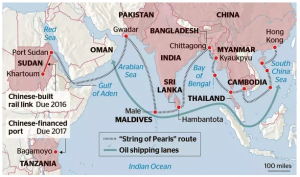

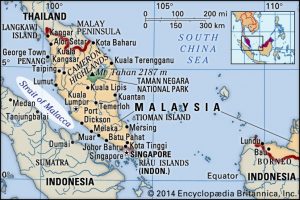
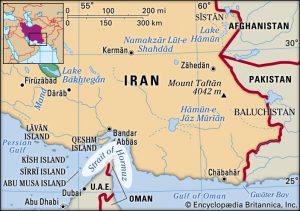
ADD TO YOUR KNOWLEDGE
